Layering Colored Pencils – Magical Effects Step by Step
This week, I have a new spread for my colored pencil journal, and it’s based on layering colored pencils. I share detailed photos so that you can try this too!
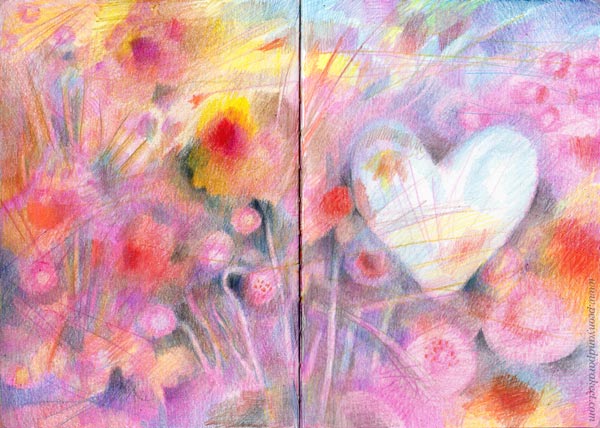
This coloring technique creates magical looseness, even if it begins with very stiff shapes. Because layering the colored pencils is the key here, it’s important to keep the layers light because paper can’t hold color endlessly.
Step 1 – Set Atmosphere
Choose a color that sets the mood for the image. My choice was pink.
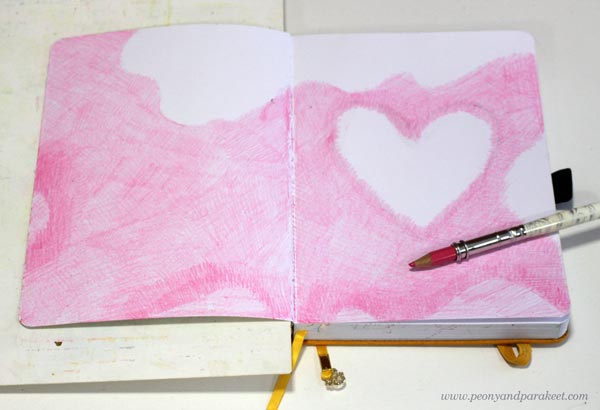
Color the background lightly, but leave some blank areas near the edges and where you want the focal point to be. The heart is my focal point.
The blank parts will allow you to include lovely color variations in the last layers. Color softly and avoid outlines so that the overall feel is magical from the first layer.
Step 2 – Add Pattern
Stick with the same pencil and continue the monotone look by coloring rings on the colored area.
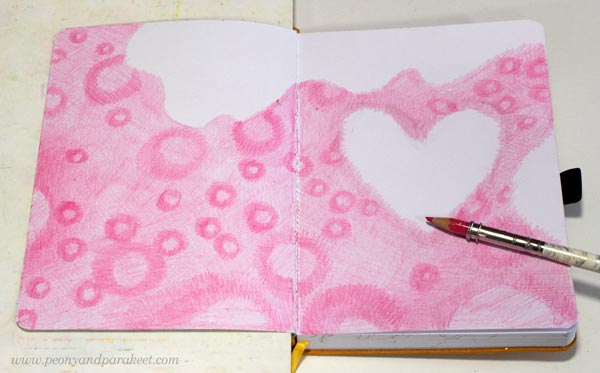
Make sure that the rings are different in size and spread a little unevenly so that the result looks natural and interesting. Think about fabrics but not the easiest polka dots, but a bit more intricate design.
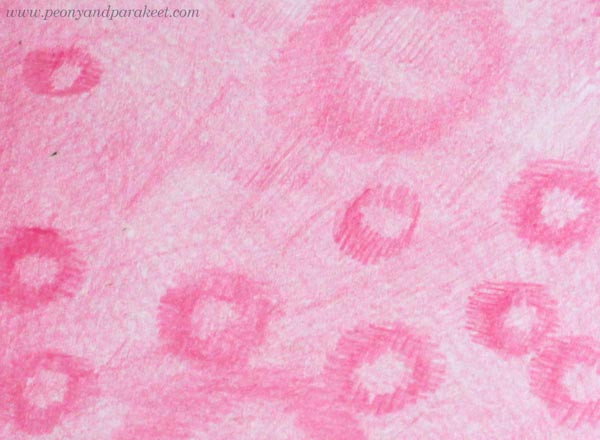
Here’s a closeup of my rings. Again, I don’t use outlines but color them with short strokes that go in many directions.
Step 3 – Destroy
This step could be called “destruction” because now we color random shapes that don’t follow the previous layers at all. Bring in new bright colors. Color stripes, rectangles, random shapes, and lines freely.
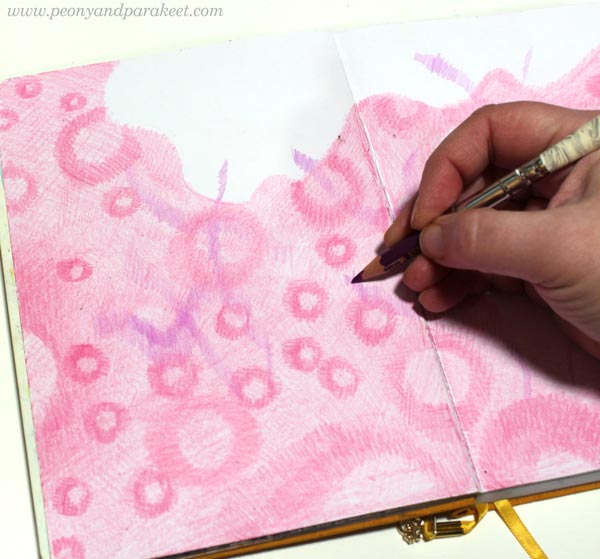
You can go over the blank parts too but keep the focal point a little less untouched.
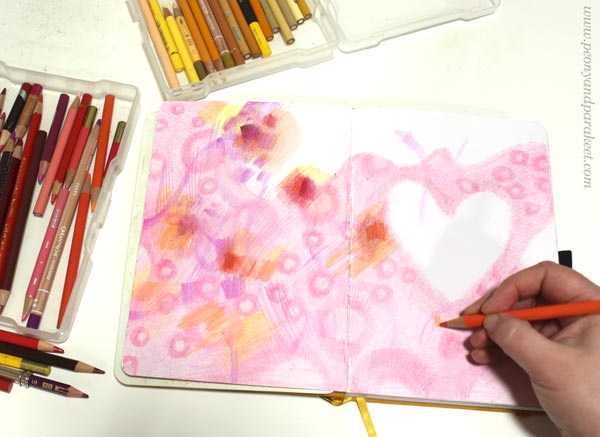
The idea is not to cover previous layers fully but to destroy their rhythm.

Here’s a closeup of my work. The new shapes and lines have taken over, and the rings are not so well visible anymore.
Step 4 – Discover
Keep coloring, but now bring in darker tones too. Keep the layers light and shapes soft, but when you discover something that you like, highlight its edges with a darker color.
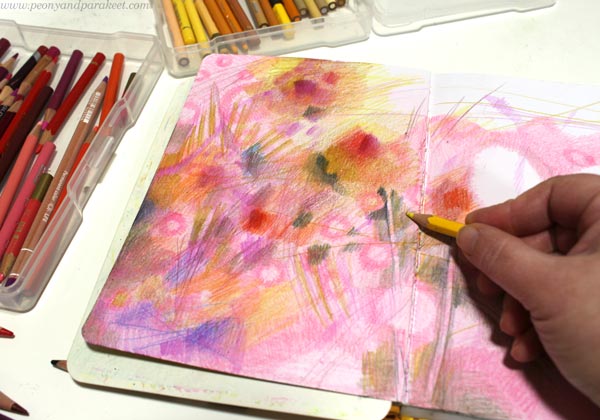
I didn’t use any green pencils in my spread, but it does have some green shades. Mixing black and yellow makes lovely olive green.
Now it’s also the time to bring some rings back to the foreground!
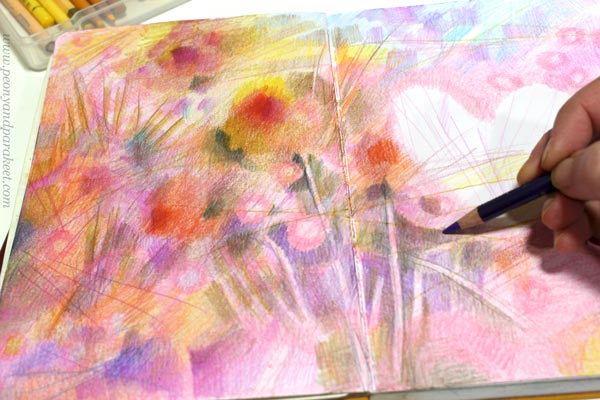
These rings remind me of perennial Bellis flowers!
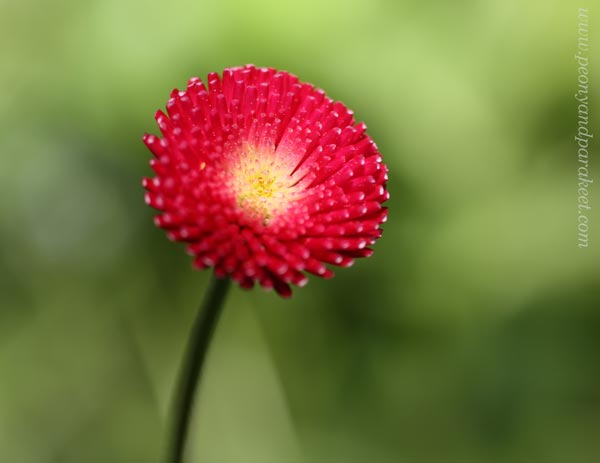
Here’s a closeup of digging out the rings – now flowers – with dark colors.
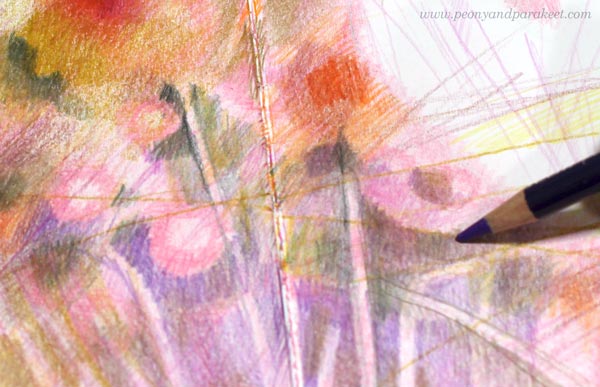
I don’t bring up all the rings, just some! This makes the layered look: some elements are covered and located further in the background, some come up to the foreground. The stiffness of the background pattern looks attractive when it’s combined with looser coloring.
Step 5 – Finish with Message
Your work will be finished when it delivers a message. The focal point, the heart in my case, is essential for achieving this. I like to work intuitively so that I don’t try to define the message right from the beginning but let the insight grow with the coloring. Here, I left the heart light and made it look icy and magical.
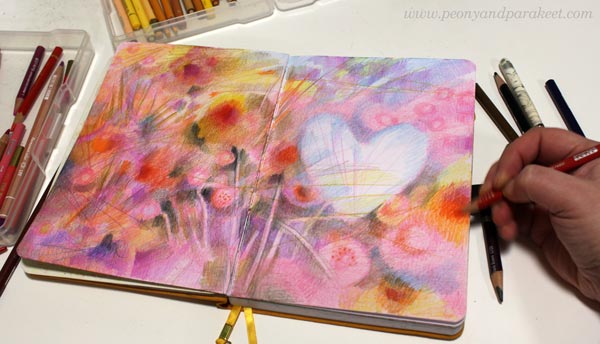
First, I thought about this winter, how tough it has been to walk the dogs on icy roads, and how much I want spring to come. And then it hit me how ice must mourn when its life is coming to an ending. How between the first flowers, there’s a little block of ice, looking around, feeling isolated.
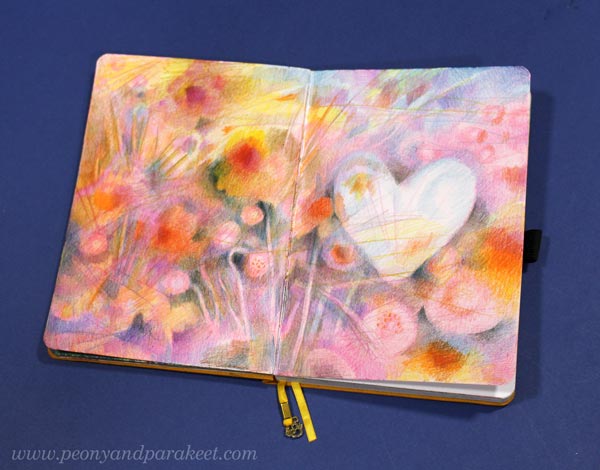
This little frozen heart is like a rare unicorn – reflecting the surroundings, introvertedly, like we all do when we are creating.
I find this kind of pondering an important part of art-making. That’s why I always try to end with a message even if viewers can freely find their explanations as well.
Fun Botanicum – Sign up Now!
From March 15 to May 15, 2022, I run an online class for us who are inspired by nature and fantasy and love plants. The class is called Fun Botanicum and we will draw fantasy plants by scribbling, doodling, and layering with colored pencils. Join us!
The early-bird sale ends soon! Early-bird price: 59 EUR, now 49 EUR. >> Sign Up Now!
The sale ends on Feb 20, 2022, at midnight PST.
Wild Botanical Art – Create with Colored Pencils and Watercolors
This week, I created wild botanical art. I drew plants with delicate details like in botanical illustrations, but with a few differences. My plants are not any real species, and the jungle where they grow is more like my inner world at its best, not a real location on the planet.
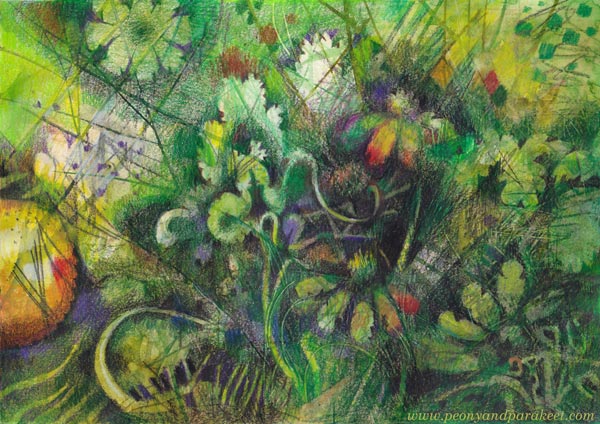
Watercolors First!
Before putting colored pencils into work, I made some backgrounds with watercolors. I had very smooth watercolor paper – hot press quality. My friend Eeva Nikunen recommended Arches Hot Press paper that she has used for detailed graphite drawings. It’s a bit pricey but so smooth and lovely for colored pencils too. However, any smooth watercolor paper would work with this technique.
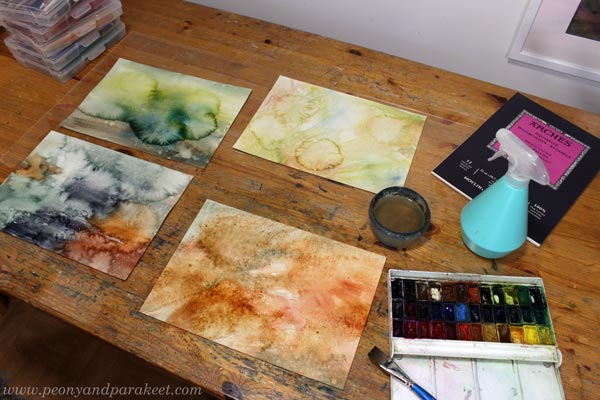
I used a lot of water for the first layer and made random splotches with a spraying bottle. This kind of wild watercolor painting is fun, but when I tried to pick one of the four experiments for colored pencils, I found the results uninspiring. So I asked myself what kinds of nature’s shapes or colors would I want to see more, and answered: “All kinds of hays inspire me a lot!”
Love for Sharp-Shaped Botanicals
We have lots of house plants that have sharp leaves.

And when I walk in nature, I always look for hays and how light hits them.
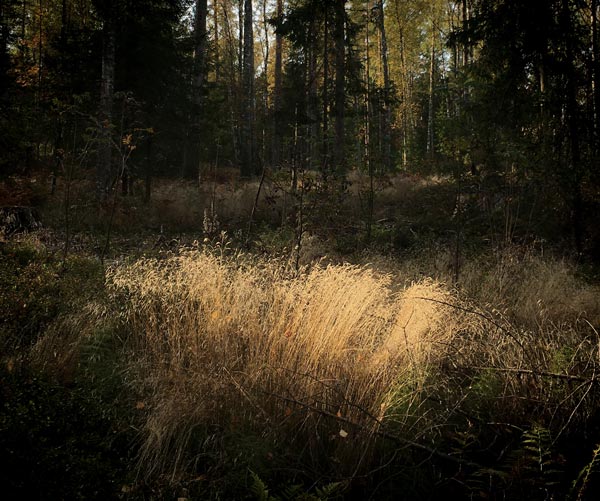
So, then after some drying time, I made thin lines that went wildly here and there.

After the lines, I found the green one on the bottom left very inviting, so I chose that for coloring.
Coloring Freely and Wildly
Colored pencils work well on the watercolor background and smooth paper. It was enjoyable to color freely. I didn’t follow the shapes or lines painted in watercolor but created new layers.
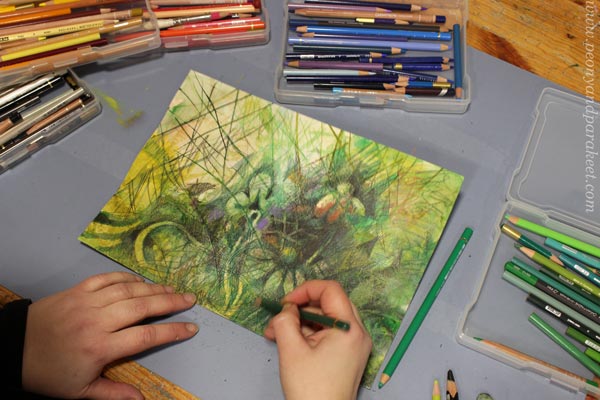
I have started to store my colored pencils in shallow plastic boxes grouped in color families. This way, every pencil gets seen, and the differences between tones are easy to identify.
Should Plant People Draw Plants?
My husband and I are plant people. Our home is filled with house plants and we have all kinds of plants in our garden. It has been quite a job to save the plants from our new puppy Saima!

Plants have also always been present in my paintings. But recently, I have thought that maybe I could focus more on them with colored pencils too. It often feels that I come home when I am inspired by plants and travel abroad when I am creating something else. I want to challenge myself out of my comfort zone, but if there’s a strong resonation, like a secret companionship, should I listen to it?
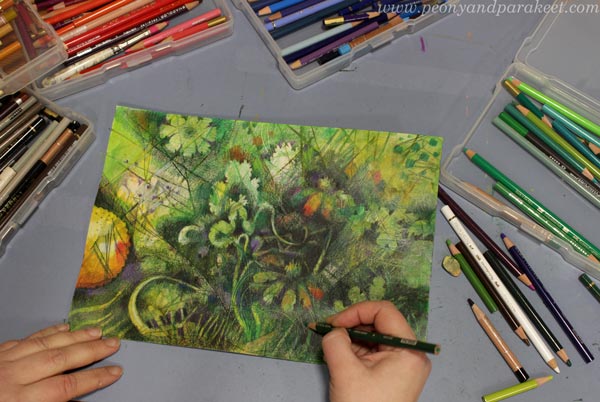
More Wild Botanical Art – Playing Mode On!
It was so much fun to work on this project that I wanted to do more. So, I colored these small scraps – a fruit and a leaf!
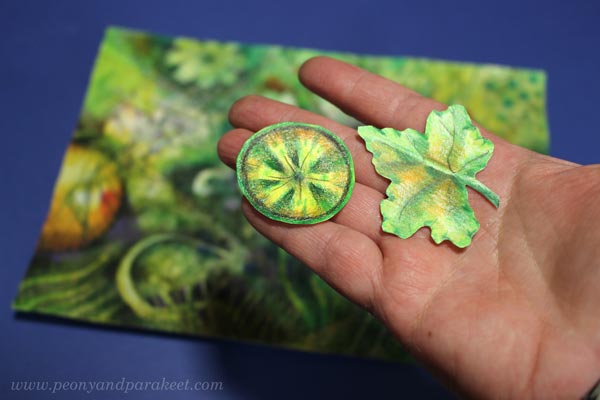
And then it was playing time. How wild can this go?
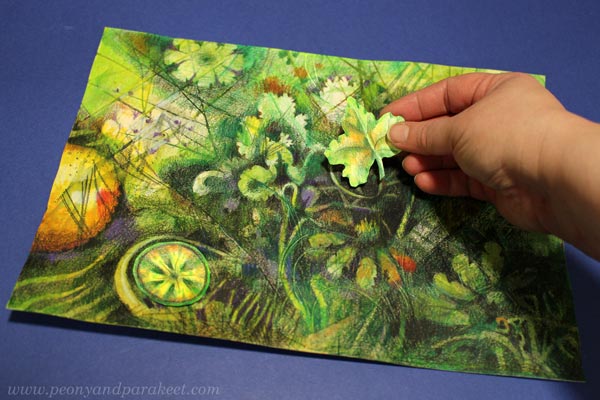
Create Wild Botanical Art – Five Tips!
- Start by creating a wilderness that calls you.
- Color layers of random shapes and lines. When you see something that could be a plant, turn it into one!
- Don’t worry about identifying the plants – treat them as rarities that only you can find!
- Make detailed a little more detailed – botanical art goes crazy with details!
- Revamp – Add some plants from your box of joy!
- Bonus tip: Nature is full of curves, so make sure you also have some.
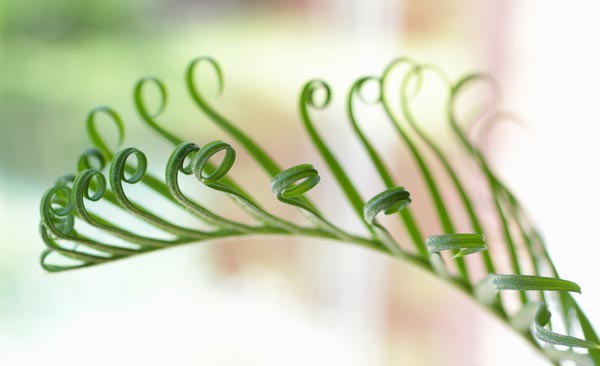
Botanical Art by Ernst Haeckel
Many years ago, a blog reader mentioned Ernst Haeckel’s botanical art. Since then, I have admired his work. Here’s a part of his illustration from 1904. Lots of greens spiced with warm colors and so many details!
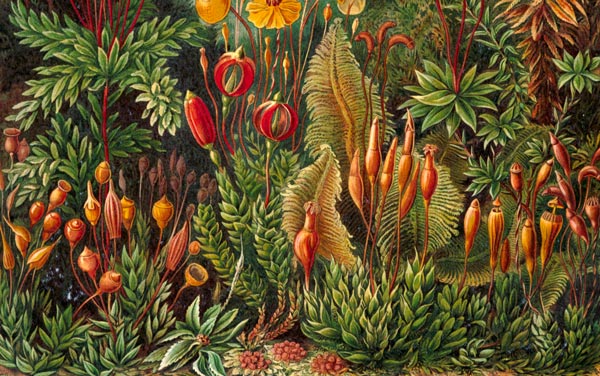
Mine is not nearly as sharp and detailed as Haeckel’s, but I approve it anyway. Plants have different personalities, and so do their interpretations!
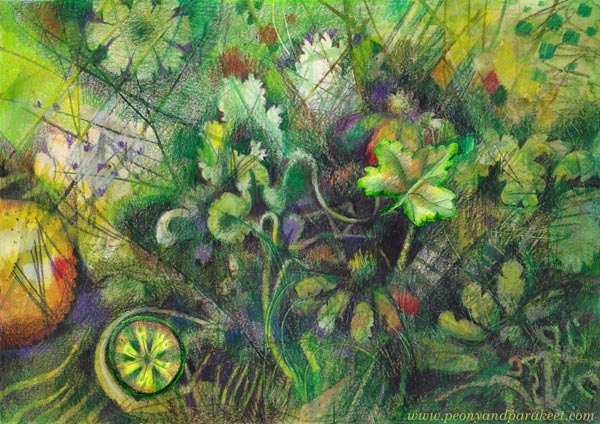
Tell me, do you like drawing plants? What kinds of plants especially?
New Free Mini-Course for Subscribers
Great news! I have updated the free mini-course “Paint the Emotion” and it’s now called “Color the Emotion.” I have added a new project with colored pencils and more talk about how to approach art-making. The mini-course is about 40-minutes long and it’s available for all the subscribers of my weekly emails.
Here I am talking about the free mini-course in a video:
P.S. If you are already subscribed, no worries! I will send you an email today with the link to the mini-course!
Joyful Flowers and Exploring Joy with Colored Pencils
Let’s draw joyful flowers together, step by step! This post is enabled by the grant that I got from Arts Promotion Centre Finland. This is the fourth blog post of the project, see the first one here, the second one here, and the third one here!
Here’s what we will create: flowers that have joyfully gathered together and reach towards the light. No references, imagination only!
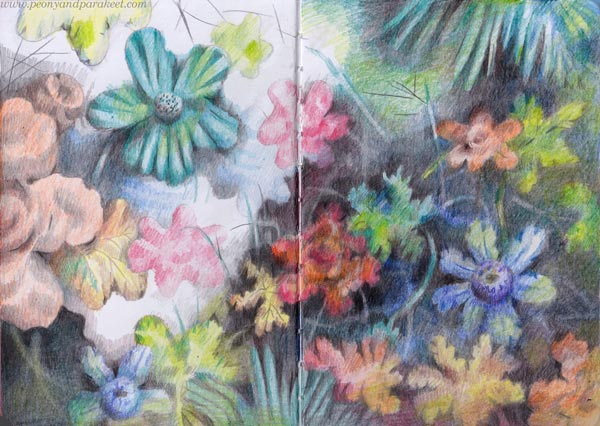
I made the drawing in my colored pencil journal and used colored pencils only. But these instructions can be easily applied to other mediums too.
Step 1 – Flowery Blobs
Pick a pencil of any color and draw blobs.
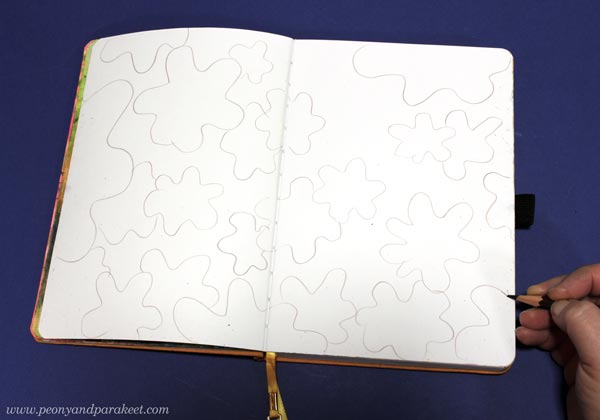
More than perfecting each flowery blob, make sure that the blobs are:
a) not similar in size – draw small, medium, and big blobs!
b) not separate – draw some only partly so that they go on the back of others!
c) not fully on the paper – draw some near the edges so that they are only partly visible!
d) not spread too evenly – leave some space too, but don’t place it in the middle!
This way, you set the foundation for joyful flowers so that you express diversity (a), togetherness (b), continuity (c), and freedom (d).
Step 2 – From a Blob to a Flower or a Leaf
Pick flowery colors and a black pencil for the background. Focus on the area in the low middle and work towards either side of the paper.
With black, color notches on the blobs so that they begin to look like flowers.
With bright and flowery colors, color some random shapes on the blobs.
Color a center for the blob to make it look more like a flower.

All the blobs don’t need the center; they can be leaves. You can also draw veins on them.
Add many colors so that the leaves and flowers look lively. Layer colors to get a variety of tones.
Step 3 – Background
Start with the black background, but gradually change to lighter tones. Leave a pitch-black area small, and add layers of other colors, like blue, on the top of the black, then gradually let the different colors take over. Leave a blank area too. Color softly and gently so that every layer adds intensity to the drawing.

One of the joys of coloring is to relax and not rush at all. Stay in a small area and work with a few flowers only (Step 1) before feeling confident enough to expand the working area and focus more on the background.
Step 3 – Setting the Colors for Joyful Flowers
You can mark the colors for each flower and leaf by coloring them carelessly first.
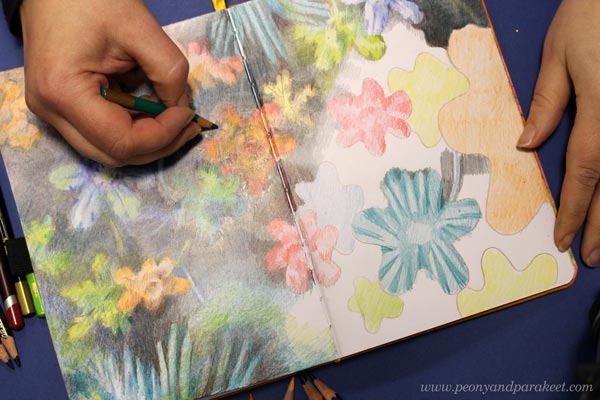
When some parts are more finished than others, there’s both joy of looking and joy of coloring!
Step 4 – Changing Most Whites to Pastels
I assume that you now have white everywhere: between the strokes, near the edges, in the flowers, and in many places on the background. But let’s change that! Leave only one area in the background that’s pure white and color over other blank parts.
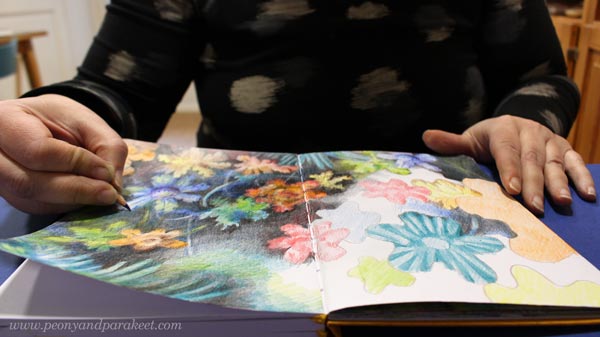
Add more color on the areas where careless coloring has left white stripes, and change the larger white areas to pastel colors. All this makes the image more joyful because the joy is in the nuances, not in the big changes.
Step 5 – The Joy of Cohesion
One of the greatest joys in art-making is to feel togetherness. So more than trying to achieve a particular style, I make changes to the image so that it feels like a place where I belong. I also want my flowers and leaves to look happy, but not so that I force them to smile by throwing “happy colors” but imagining that everyone has a friend in the scenery: someone to trust and lean on.
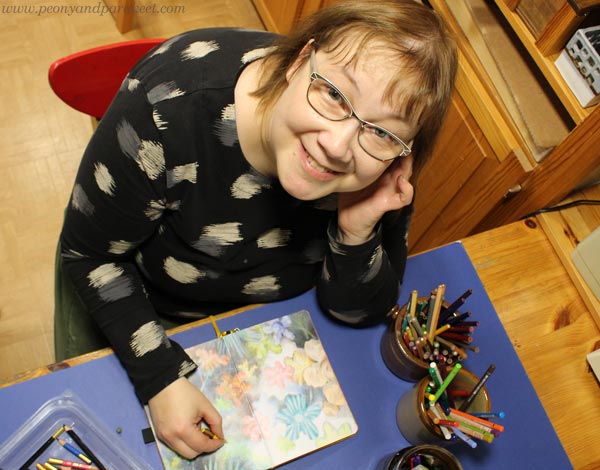
I also make some flowers look like me: who need to feel free to bloom. So they are less defined and almost disappear into the light, but their spirit still looks strong. So, the less realistic a flower is, the more room there’s for the expression.
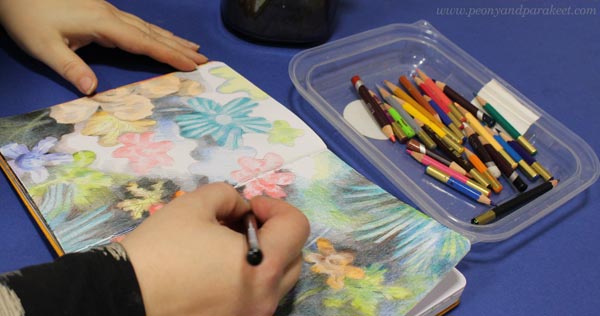
At some point in art-making, I begin to question if other people will like the image. It’s comforting to know that if we manage to create the feeling of effortless belonging, the image will naturally resonate more widely. The joy of cohesion also allows something to go wrong and become different than we expected. If we make every element feel accepted and welcomed, joy will naturally appear.
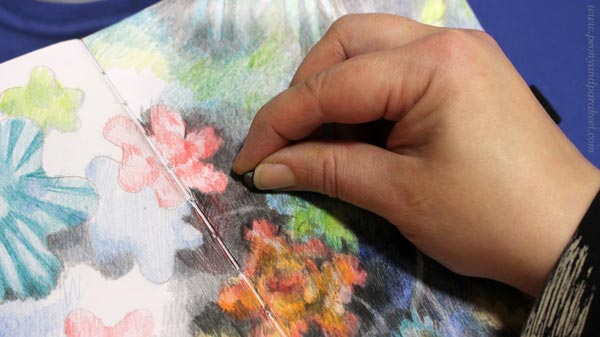
I a flower or a leaf looks lonely, add a stem that connects it with others. Long lines can look commanding and stiffen the image, so erase a glimpse of a stem only. Stems also look more natural if they don’t start right from the flower but appear and disappear as softly as possible. Stems can also go across each other and form a connecting mesh.
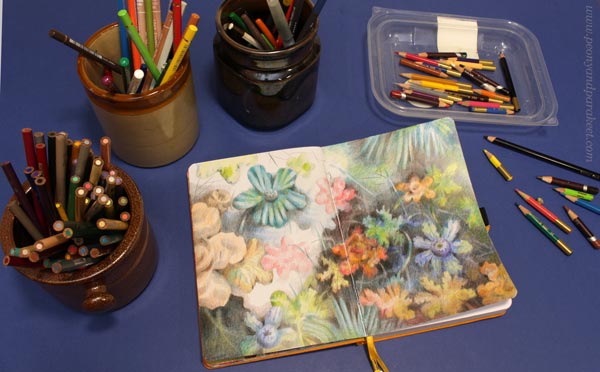
When one flower leads to another, and the eye always finds a clue about where to look next, cohesion is present.
More Inspiration for Joyful Flowers
I have got so many ideas from flowers that even when I don’t create them, my visual language is very flowery.
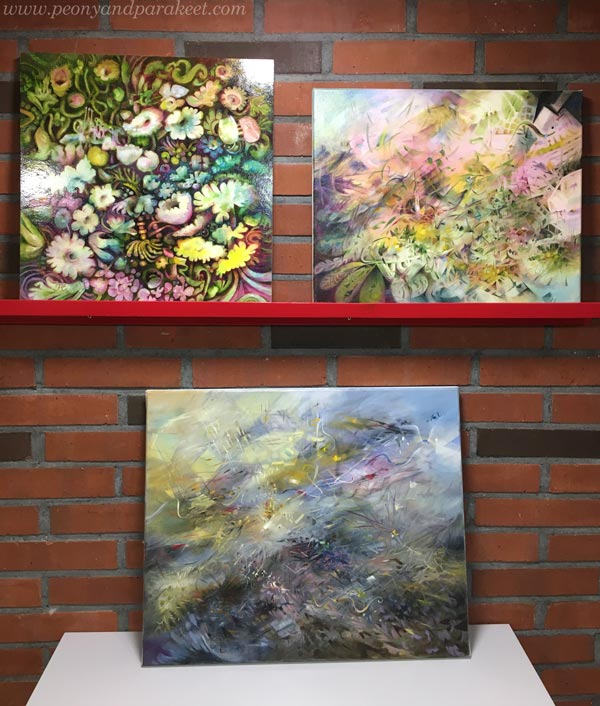
This week, I started two big oil paintings. These are 120 x 100 cm – it’s the biggest size that I have ever painted!

My first inspiration source for these is floral still lives from the 17th century. But these are just beginnings, and let’s see how they will progress in the upcoming weeks.
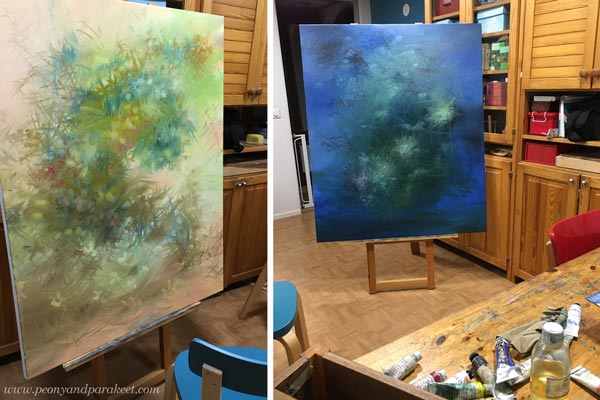
My little studio has been full of projects this week and will continue to be so!
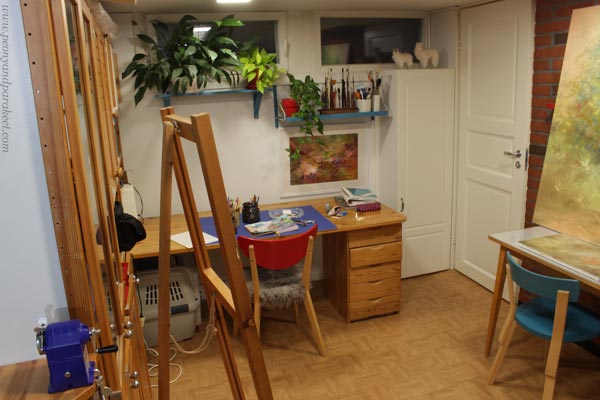
I hope this blog post inspires you to create joyful flowers – big or small, pencils or paints!